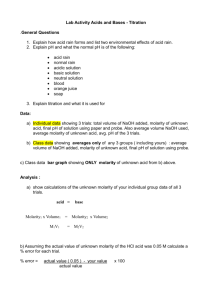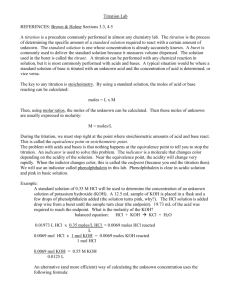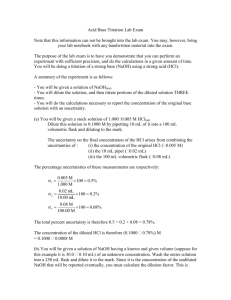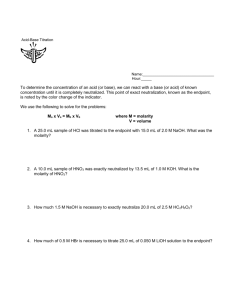Titrations Made Easy - C12-5-06
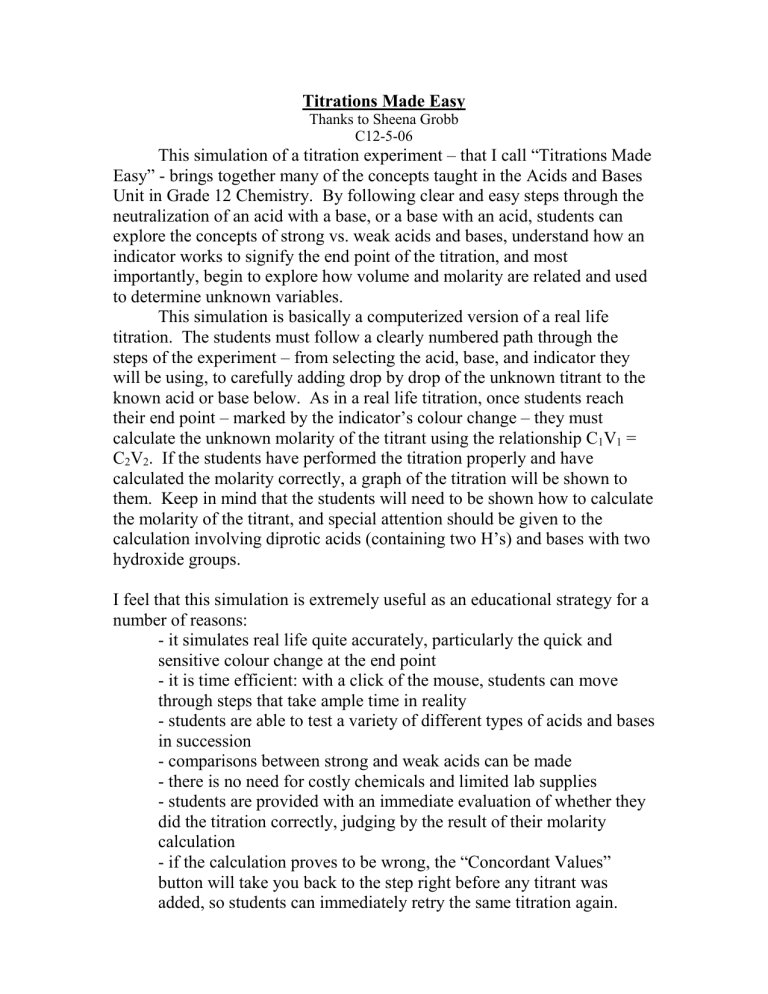
Titrations Made Easy
Thanks to Sheena Grobb
C12-5-06
This simulation of a titration experiment – that I call “Titrations Made
Easy” - brings together many of the concepts taught in the Acids and Bases
Unit in Grade 12 Chemistry. By following clear and easy steps through the neutralization of an acid with a base, or a base with an acid, students can explore the concepts of strong vs. weak acids and bases, understand how an indicator works to signify the end point of the titration, and most importantly, begin to explore how volume and molarity are related and used to determine unknown variables.
This simulation is basically a computerized version of a real life titration. The students must follow a clearly numbered path through the steps of the experiment – from selecting the acid, base, and indicator they will be using, to carefully adding drop by drop of the unknown titrant to the known acid or base below. As in a real life titration, once students reach their end point – marked by the indicator’s colour change – they must calculate the unknown molarity of the titrant using the relationship C
1
V
1
=
C
2
V
2
. If the students have performed the titration properly and have calculated the molarity correctly, a graph of the titration will be shown to them. Keep in mind that the students will need to be shown how to calculate the molarity of the titrant, and special attention should be given to the calculation involving diprotic acids (containing two H’s) and bases with two hydroxide groups.
I feel that this simulation is extremely useful as an educational strategy for a number of reasons:
- it simulates real life quite accurately, particularly the quick and sensitive colour change at the end point
- it is time efficient: with a click of the mouse, students can move through steps that take ample time in reality
- students are able to test a variety of different types of acids and bases in succession
- comparisons between strong and weak acids can be made
- there is no need for costly chemicals and limited lab supplies
- students are provided with an immediate evaluation of whether they did the titration correctly, judging by the result of their molarity calculation
- if the calculation proves to be wrong, the “Concordant Values” button will take you back to the step right before any titrant was added, so students can immediately retry the same titration again.
- a graph of the titration is immediately given
Some limitations of this simulation include:
while a weak acid is available for titration, there are no weak bases
the unknown variable is always the molarity of the titrant, never an unknown volume or unknown molarity in the sample solution
students miss out on the “hands on” benefits of a real lab
The following SLO’s from the Grade 12 Curriculum are related to the
Titrations Made Easy simulation (with emphasis on C12-5-10 ):
Describe how an acid-base indicator works in terms of the colour shifts and Le Chatelier’s Principle
Distinguish between weak and strong aqueous solutions of acids and bases
Calculate the concentration or volume of an acid or base from the concentration and volume of an acid or base required for neutralization.
Reference: http://www.chem.iastate.edu/group/Greenbowe/sections/projectfolder/anima tionsindex.htm
Click on: simulation download page
Click on: Acid-Base Equilibria
Click on: Acid-base pH titration simulation
Titrations Made Easy
Thus far in our Acids and Bases Unit we have balanced acid/base chemical reactions and studied acid/base conjugate pairs, examined how acid/base indicators work, practiced a variety of calculations using pH, pOH,
[H30+] and [OH-], and distinguished between weak and strong aqueous solutions of acids and bases. Now we are moving into the next phase of acid/base chemistry as we look at Neutralizations. This activity will help us explore neutralization reactions using a simulation of a titration lab.
You have the option of working alone or in pairs, availability of computers permitting. At the end of each titration, you will be calculating an unknown molarity that will require you to record your calculations in the spaces provided in this handout. You will also be asked a series of questions about the titration related to lessons previously taught in the Acids and Bases
Unit, as well as more involved questions expanding on the concepts being explored in this simulation.
Curriculum Objectives:
- to learn how to perform a titration properly and to understand why each step is conducted the way it is
- to calculate the molarity of an unknown acid or base using the volume and molarity of a known base or acid respectively, along with the volume required of the unknown acid or base to reach neutralization (ie. the coloured end point)
- to get a better understanding of the difference between a weak acid mixed with a strong base, and a strong acid mixed with a strong base.
- to be able to articulate what is happening on a particulate level during the titration and particularly during the moment of neutralization.
Let’s get started!
Log on to the Internet (via. Mozilla Firefox , Netscape , Internet Explorere r, etc.) and go to the following web site: http://www.chem.iastate.edu/group/Greenbowe/sections/projectfolder/anima tionsindex.htm
Click on: simulation download page
Click on: Acid-Base Equilibria
Click on: Acid-base pH titration simulation
We will work through an example together:
1. Click on Strong Acid vs. Strong Base.
2. Fill the Burette with Acid
3. Select HCl as your acid, and KOH as your base
- Note that because you selected “Strong Acid vs. Strong Base” you have only been given strong acids and bases as options here.
4. Select Methyl Red as your indicator
- Note that Bromothymol Blue will also work here; it turns a different colour when the end point has been reached.
5. You are ready to perform the titration. Carefully add small amounts of
HCl using the “slider” or the “dropwise” button until you just reach a colour change. Accuracy is important here. If you overshoot the end point and add too much acid, press the “Concordant Values” button and begin Step 5 again.
6. Once you have accurately reached a colour change, you are ready to calculate the unknown molarity of HCl (Note the volume and molarity of
KOH have been given). The colour change signifies that you have reached the point in the titration where the number of moles of H+ from your acid,
HCl, equals the number of moles of OH- from your base, KOH, forming water molecules and hence neutralizing the solution. On a symbolic level, the equation looks like this:
Ex: HCl + KOH KCl + H
2
0
In general: HA + BOH
AB + H
2
0
One important point to remember when neutralizing an acid with a base and visa versa is that one hydrogen ion from the acid combines with one hydroxide ion from the base to form a molecule of water. If the acid is diprotic (has two H’s) or if the base has two hydroxide ions, you must remember to balance the general equation accordingly:
H
2
A + 2BOH
B
2
A + 2H
2
0
To Calculate the Molarity of your unknown acid or base (ie. HCl):
A. Calculate the # of moles of known acid/base (ie. KOH)
Moles = Molarity(mol/L) x Volume(L)
Pay attention to Units!!!
B. Moles of OH- = Moles of H+
(since KOH and HCl have only one OH- and H+ respectively)
Moles of KOH = Moles of HCl)
C. Using answer from step 1 and volume of unknown (ie. HCl) added in the titration, calculate the Molarity of the unknown (ie. HCl)
Molarity = Moles
Volume(L)
(space provided to show your work)
Enter your answer into the Molarity space at Step 6 and see if you are correct!
7. If you are correct, go on to see the titration curve by clicking on “Graph.
Sketch the graph below. If you are incorrect, recheck your calculations or redo your titration to ensure you acquired an accurate volume.
Try the following acid base combinations (and feel free to experiment with your own variations):
H
2
SO
4
and NaOH
HNO
3
and Sr(OH)
2
CH
3
COOH (weak acid) and KOH
Questions:
Q1. In your own words, explain the purpose of an acid-base titration.
Q2. In your own words, describe what is taking place on the particulate level
(ie. looking at the ions and molecules) when an acid neutralizes a base.
Q3. What is the role of the indicator? What does a colour change signify?
Q4. Describe the Titration Curves that were formed after each Titration.
Was there a pattern in the graphs of any kind?
Q5. How did HCl (strong acid) differ from C
3
COOH (weak acid) when each were titrated with KOH? How did their Titration Curves differ?
Conclusion:
The activity you have just completed is a simulation of a real life titration experiment, but keep in mind it is not exactly the same as the actual lab. It is important that you develop hands on skills with lab materials as well – this is not a replacement of the lab. Consider this simulation an excellent learning tool as you work your way through understanding the concepts presented in acid-base chemistry.
The purpose of this simulation was to explore how titrations work and why they are useful to us. By understanding the neutralization reaction that occurs between an acid and a base, we can solve for unknown variables in molarity or volume for either the acid or the base. We can also see how the strength of the acid and base affects the neutralization reaction by looking at the Titration Curve. Perhaps most importantly, this simulation allows for quick and easy trial and error exploration, without wasting chemicals and time.




